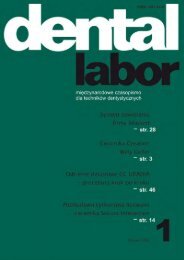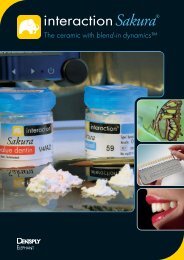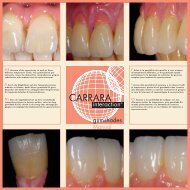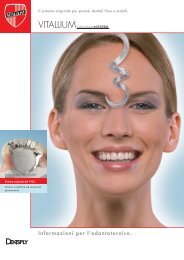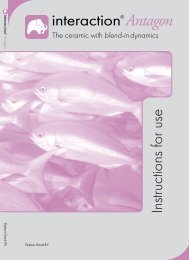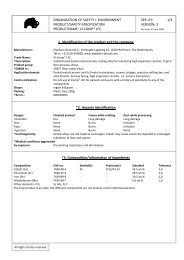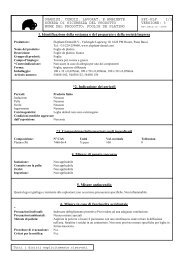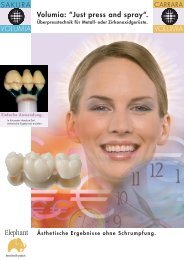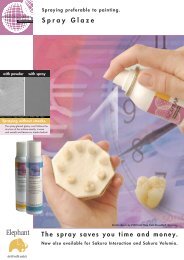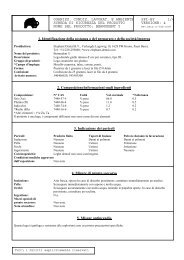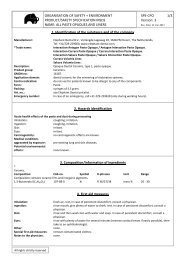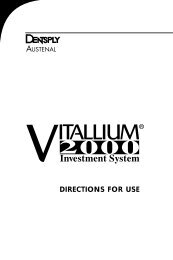alloy/alliage/ lega/legierung/ aleación/ Dentaal ... - Elephant Dental
alloy/alliage/ lega/legierung/ aleación/ Dentaal ... - Elephant Dental
alloy/alliage/ lega/legierung/ aleación/ Dentaal ... - Elephant Dental
You also want an ePaper? Increase the reach of your titles
YUMPU automatically turns print PDFs into web optimized ePapers that Google loves.
Das Gegengewicht des Zentrifugalarms auf die korrektePosition einstellen, um für einen reibungslosen undbalanciertenGussvorgang zu sorgen. Befolgen Sie die Anweisungen fürdas von Ihnen verwendete Gussgerät. Die Legierungschmelzen, in die vorgewärmte Muffel gießen und dieMuffel vor der weiteren Verarbeitung auf dem Arbeitstischabkühlen lassen.MUFFELN NICHT RASCH ABKÜHLEN ODER ABSCHRECKEN,DA DIES ZU EINEM VERZIEHEN DER GUSSOBJEKTE & UNDUNERWÜNSCHTEN VERÄNDERUNGEN DER MECHANISCHENEIGENSCHAFTEN DER LEGIERUNG FÜHREN KANN.aNWEISUNg FüR DaS gIESSEN MIT OFFENER FlaMMEWarnhinweise: Beim Schmelzen und Gießen mitoffener Flamme äußerste Vorsicht walten lassen. DieAnweisungen und Warnhinweise des Brenner-Herstellersbefolgen und bei der Verwendung eines Propan-Sauerstoff-Brenners einen speziell hierfür entwickeltenAugenschutz tragen.Je nach Spannung der Feder 3-5 Umdrehungen amGussarms verwenden. Das Gegengewicht entsprechendder Größe des zu gießenden Objekts auf die korrektePosition einstellen.Druckregler und Durchflussmesser für Sauerstoff-Acetylen-Schmelzbrenner verwenden.Vorgewärmte Muffel und Gusstiegel in das Gussgerätsetzen. Erforderliche Menge der Guss<strong>legierung</strong> in denTiegel geben. Brenner anzünden und die Flamme langsamund kreisförmig über das Metall bewegen. Diese Bewegungfortsetzen, um die Legierung gleichmäßig zu erhitzen undzu schmelzen. Wenn die Legierung zu schmelzen beginnt,fallen die Gusswürfel und Gusskegel zusammen. DieLegierung weiter gleichmäßig erhitzen, bis zu sehen ist,wie die geschmolzene Legierung zusammenfließt und sichunter dem Druck der Flamme bewegt. Die Legierung NICHTüberhitzen.anmerkung: Der Oxidfilm sollte nicht reißen.Den Gussarm freigeben und schleudern lassen, bis er zumStillstand gekommen ist. Muffel herausnehmen und vorder weiteren Verarbeitung auf dem Arbeitstisch abkühlenlassen.MUFFELN NICHT RASCH ABKÜHLEN ODER ABSCHRECKEN,DA DIES ZU EINEM VERZIEHEN DER GUSSOBJEKTE & UNDUNERWÜNSCHTEN VERÄNDERUNGEN DER MECHANISCHENEIGENSCHAFTEN DER LEGIERUNG FÜHREN KANN.aNWEISUNgEN zUR REINIgUNg VON TEIlpROTHESEN:Prothesen aus der Legierung Vitallium können mithandelsüblichen Prothesenreinigern oder Zahnpastengereinigt werden, auf deren Etiketten angegeben ist, dasssie für die Reinigung von “Brücken, kieferorthopädischenApparaturen und/oder Teilprothesen” geeignet sind. DieVerwendung von Reinigern mit hohem Hypochrolit-Gehaltund von Haushalts-Bleichmittel wird nicht empfohlen, dadiese zu Verfärbungen oder Erosionen des Metallgerüstsführen können.MaTERIalIEN FüR DIE REpaRaTUR VON gERüSTENHERgESTEllT aUS VITallIUM-lEgIERUNgEN :Lot/Laser SchweissdrahtNachbestellnummerVitallium Lot. ........................N041200 & 01, EU8041201Nickelfreiem Lot ............................N041005, EU8041005.800 Weißgoldlot ..........................N085100, EU8085100Vitallium Laser Schweißdraht Ø 0,5mm (Stab) EU8041100Vitallium Laser Schweißdraht Ø 0,35mm (Roll)EU8041135Vitallium Laser Schweißdraht Ø 0,50mm (Roll)EU8041150pHYSIKalISCHE & MECHaNISCHE EIgENSCHaFTEN0,2- %-Dehngrenze ............................................616 MPaZugfestigkeit......................................................855 MPaElastizitätsmodul................................................200 GPaBruchdehnung ....................................................... 4,5 %Vickers-Härte......................................................428 HV5Dichte.............................................................. 8,3 g/cm 3Farbe ....................................................................... grauSchmelzintervall .......................................1300-1370 °Czusammensetzung (gewichts %)Kobalt ..................................................................60,6 %Chrom ..................................................................31,5 %Molybdän ...............................................................6,0 %Mn, Si, C < 1,0%Die Legierung Vitallium enthält weder Nickel noch Beryllium.IndicacionesLa aleación Vitallium es una aleación para modeladobasada en cobalto-cromo-molibdeno diseñada parausarse en el modelado de estructuras metálicas deprótesis dentales parciales de quita y pon.Contraindicaciones1. La aleación Vitallium está contraindicada en pacientesy usuarios con antecedentes de sensibilidad al cobalto,cromo y molibdeno.advertencias1. La exposición prolongada a los humos y/o polvos dela aleación puede causar irritación pulmonar y/ocomplicaciones pulmonares. Utilice los controles deingeniería apropiados para limitar la exposición. Enlos casos de excesiva inhalación de humos o polvos,busque atención médica.2. Esta aleación contiene cromo. Algunos compuestosde estos elementos tienen potencial carcinógeno.Informe a su proveedor médico de la exposición aestos elementos.3. Esta aleación contiene elementos conocidos enCalifornia por ser carcinógenos.precauciones1. Cuando funda, rebaje o pula aleaciones, utilice laventilación adecuada, sistemas de aspiración o vacío,protección ocular, y ropa y mascarillasprotectoras.Reacciones adversas1. La exposición a los humos o al polvo de la aleaciónpuede causar irritación ocular y/o complicacionesrespiratorias.2. Determinados componentes de las aleaciones tienenpotencial carcinógeno. Vea el apartado“Advertencias”.INSTRUCCIONES PASO A PASOpROCESSINg INSTRUCTIONS:Recomendaciones para revestimiento: Utilice un sistemade revestimiento con silicato de etilo deDENTSPLY Austenal:Nº ref.Revestimiento VR .................... N022065, EU8022065Binder VR .....................................N023001, EU8023005Binder Thinner VR ........................N024001, EU8024005Recomendaciones para el material de duplicación:Use material reversible hidrocoloide de duplicaciónperflex® (nº ref. N021055) con el revestimiento VR.El material de duplicación Silflex® III de polivinil siloxano(nº ref. N021501) se recomienda para usarlo en laduplicación de modelos en moldes con dispositivos desujeción de precisión y para moldes de combinación.NOTa: Siga las instrucciones del material de revestimientoy duplicación que esté utilizando para modelos refractariosy los pasos de revestimiento.EQUIpO:REQUISITOS DEl HORNO DE QUEMaDO:para revestimiento VR: Horno de gas de alta temperaturacapaz de alcanzar una temperatura de 1177 °C (2150 °F).MÁQUINaS DE MODElaDO:Máquina de modelado DENTSPLY Austenal ECM IV o unaMáquina de modelado con soplete, esto es un soplete deoxígeno acetileno de múltiples orificios y brazo centrífugode modelado activado por resorte.INSTRUCCIONES DE QUEMaDO: Precalentar los moldes derevestimiento y un crisol limpio de modelado siguiendo elciclo recomendado de quemado para el revestimiento quese vaya a utilizar. Asegúrese de que los crisoles solamentese utilizan para esta aleación y que los crisoles utilizados notienen escoria ni ningún resto de metal.INSTRUCCIONES DE MODElaDO: Relación de metalvirgen/reusado: Para mantener las propiedades físicas ymecánicas de esta aleación se recomienda usar al menos50% de metal nuevo para cada modelado. El materialreusado (botones) debe chorrearse con arena y limpiarseantes de volver a utilizarse.Al seguir esta recomendación, la composición química dela aleación se mantendrá y se evitará el exceso de óxidoo la acumulación de escoria en la aleación (una de lasprincipales causas de picaduras en los modelos).paRÁMETROS DE la MÁQUINa DE MODElaDODENTSplY aUSTENal ECM IVAjuste de latemperatura de modelado: .............. 2820°F Vitallium ScaleTemporizador de remojo: .................................. 5 segundosSelector de fusión: ....................................................... Altoajuste del reductor de aceleración:Moldes pequeños - 50 Moldes grandes - 75 a 100 RPM:380-400Ajuste el peso del contador del brazo centrífugo en laposición adecuada para permitir una operación demodelado equilibrada y suave.Siga las instrucciones de la máquina que esté usando.Funda y modele la aleación en el molde precalentado derevestimiento y deje que los moldes se enfríen en la mesade trabajo antes de procesarlos más.NO FUERCE EL PROCESO DE ENFRIAMIENTO NI ENFRÍERÁPIDAMENTE LOS MOLDES YA QUE ESTO PODRÍA CAUSARLA DEFORMACIÓN DE LOS MOLDES Y CAMBIOS NO DESEADOSEN LAS PROPIEDADES MECÁNICAS DE LA ALEACIÓN.INSTRUCCIONES DE MODElaDO CON SOplETE:advertencia: Tenga extremo cuidado durante lasoperaciones de fusión con soplete. Siga las instrucciones yadvertencias del fabricante del soplete y utilice equipo deprotección para los ojos diseñado para utilizarlo cuandose use un soplete de oxígeno acetileno.Use 3-5 vueltas en el brazo de modelado dependiendo dela tensión del resorte. Ajuste las contrapesas en la posicióncorrecta de acuerdo al tamaño del molde que se vaya amodelar.Coloque un soplete de oxígeno acetileno de múltiplesorificios con reguladores de presión y caudalímetros.Coloque el molde precalentado y el crisol en la máquina demodelado. Coloque la cantidad necesaria de aleación en elcrisol.Encienda el soplete y con un movimiento circular, muevala llama lentamente sobre el metal. Continúe con estemovimiento para calentar y fundir uniformemente la aleación.Cuando la aleación empieza a fundirse, los lingotes ybotones se colapsarán. Añada fundente y siga calentandouniformemente la aleación hasta que pueda verse que laaleación fundida se desliza y mueve bajo la presión de lallama. NO calentar excesivamente la aleación.Nota: la película de óxido no debe romperse.Libere el brazo de modelado y deje que éste se paretotalmente. Retire el molde y deje que se enfríe en la mesade trabajo antes de procesarlo más.NO FUERCE EL PROCESO DE ENFRIAMIENTO NI ENFRÍERÁPIDAMENTE LOS MOLDES YA QUE ESTO PODRÍA CAUSARLA DEFORMACIÓN DE LOS MOLDES Y CAMBIOS NO DESEADOSEN LAS PROPIEDADES MECÁNICAS DE LA ALEACIÓN.INSTRUCCIONES paRa lIMpIaR laS pRÓTESIS DENTalESpaRCIalES: Las prótesis dentales de aleación Vitalliumpueden limpiarse con limpiadores comerciales indicadospara prótesis dentales o pastas dentífricas cuyas etiquetasindiquen que son adecuadas para limpiar “puentes, aparatosortodónticos y/o prótesis dentales parciales”. No serecomienda el uso de limpiadores con alto contenido enhipoclorito y el uso de lejía doméstica ya que podría causarel deslustrado o picado de la estructura metálica.INSTRUCCIONES paRa REpaRaR la ESTRUCTURa METÁlICaDE alEaCIÓN VITallIUM:Las estructuras metálicas pueden repararse con la varilla desoldadura Vitallium (nº ref. N041200 y 01) o la varilla desoldadura sin níquel (nº ref. N041005) o soldadura de oroblanco (nº ref. N085100 o N085200).pROpIEDaDES FÍSICaS Y MECÁNICaSLímite de alargamiento 0,2% ............ 89.350 psi (616 MPa)Resistencia final a la tracción.......... 124.000 psi (855 MPa)Módulo de elasticidad ..............29 X 10 6 psi (20 x 10 4 MPa)Porcentaje de elongación ........................................... 4,5%Dureza Vickers ................................................... 428 VHN1Densidad............................................................... 8,3 g/ccIntervalo de fusión ..................1300-1370°C (2375-2500°F)Composición (% masa)Cobalto .................................................................... 60,6%Cromo ...................................................................... 31,5%Molibdeno.................................................................. 6,0%Mn, Si, C < 1,0%La fórmula de la aleación Vitallium no contiene níquel ni berilio.IndicatiesVitallium is een kobalt basis gietlegering voor hetvervaardigen van uitneembare dentale restauraties.Contra-indicaties1. Vitallium niet gebruiken indien bekend is dat de patiëntof gebruiker overgevoelig is voor kobalt, chroom enmolybdeen.Waarschuwingen1. Langdurige blootstelling aan stof en/of dampen van delegering kunnen leiden tot irritatie van de longen en/oftot ademhalingsproblemen. Raadpleeg het veiligheidsinformatieblad voor meer informatie.Voorzorgsmaatregelen1. Zorg bij het smelten, beslijpen of polijsten vanlegeringen voor goede ventilatie en maak gebruik vaneen afzuiginstallatie. Draag bij bewerking eenbeschermende bril, een beschermend mondmasker enbeschermende kleding.bijwerkingen1. Blootstelling aan stof en/of dampen van de legeringkunnen leiden tot irritatie van de ogen en/of totademhalingsproblemen.2. Enkele bestanddelen van legeringen zijn mogelijkkankerverwekkend. Zie de waarschuwingen. Raadpleeghet veiligheidsinformatieblad.STAPSGEWIJZE AANPAKINSTRUCTIES VOOR VERWERKINg:adviezen voor het inbedden:Gebruik een ethylsilicaat gebonden inbedsysteem vanDENTSPLY Austenal: bestelnummers voor nabestellingenInbedsysteem:BestelnummerInbedmassa VR .............................N022065, EU8022065VR Binder .........................................N023001, EU8023005VR Binder Thinner .............................N024001, EU8024005aanbevelingen voor het dupliceermateriaal:Gebruik bij Vitallium inbedmassa het perflex® reversibelehydrocolloïd-dupliceermateriaal (bestelnummer: N021055,EU8021055).Voor het dupliceren van modellen met precisie-attachmentsen gecombineerde voorzieningen wordt het polyvinylsiloxaan-dupliceermateriaalSilflex® III (bestelnummerN021501) aangeraden. Voor EU gebruikers bevelen wij bijdeze indicatie Silflex Blue (Shore25) Art.Nr. 8021550-8021560 Componente A&B 5kg aan.OpMERKINg: Volg de instructies voor het inbed- endupliceermateriaal op dat u gebruikt voor het vuurvastemodel en het inbedden.gIETMaCHINES:De DENTSPLY Austenal ECM IV gietmachine of eenvlamgietapparaat, d.w.z. een centrifugale gietarm metveeractivering, met een propaan-zuurstof brander.INSTRUCTIES VOOR HET VOORVERWaRMEN: Verwarm degietmoffels en een schone gietkroes conform de voor degebruikte inbedmassa aanbevolen voorverwarmcyclus.INSTRUCTIES VOOR HET gIETEN: Verhouding tussen nieuwen oud metaal: Gebruik voor het behoud van defysische en mechanische eigenschappen van deze legeringbij ieder gietprocédé ten minste 50% nieuw metaal. Zorgdat eerder gegoten kegels en kanalen grondig wordengezandstraald en gereinigd voor dat ze opnieuw voor hetgieten worden gebruikt. Door dit advies op te volgen blijft dechemische samenstelling van de legering constant envormen zich zo min mogelijk oxiden en slakken (een van dehoofdoorzaken van insluitingen in gietobjecten).INSTEllINgEN VaN DE DENTSplY aUSTENal ECM IVgIETMaCHINEInstelling giettemperatuur:................1550ºC Vitallium-scalaTimer voor de houdtijd: ......................................5 secondenSmeltkeuzeschakelaar: .................................Op hoog (high)INSTEllINg Slingergiet-apparaat:Kleine gietobjecten – 50, groot gietobject – 75 à 100Toerental: 380-400Stel het contragewicht van de centrifugearm in op de juistepositie, zodat een soepel en uitgebalanceerd gietprocédémogelijk is.Volg de instructies voor de door u gebruikte gietmachine op.Smelt de legering, giet hem in de voorverwarmde moffelen laat de moffel voor verdere verwerking afkoelen op dewerktafel.KOEL DE MOFFELS NIET SNEL AF EN LAAT ZE NIETAFSCHRIKKEN. DIT KAN VERVORMING VAN DE GIETOBJECTENVEROORZAKEN EN KAN ONGEWENSTE MECHANISCHEVERANDERINGEN IN DE LEGERING TEWEEGBRENGEN.INSTRUCTIES VOOR HET gIETEN MET OpEN VlaM:Waarschuwingen: Ga bij het smelten en gieten metopen vlam zeer voorzichtig te werk. Houd u daarbij aande instructies en waarschuwingen van de fabrikant vande brander en draag bij het werken met propaanzuurstofbranderseen speciale beschermingsbril.Werk, al naar gelang de spanning op de veer, metminimaal 3 tot 5 draaiingen van de centrifugearm. Stel hetcontragewicht afhankelijk van de moffelgrootte van het tegieten object in op de juiste positie.Gebruik een propaan-zuurstoffbrander met drukregeling endebietmeter. Plaats de voorverwarmde moffel en degietkroes in het gietapparaat.Doe de juiste hoeveelheid van de gietlegering in desmeltkroes.Steek de brander aan en beweeg de vlam in langzaamdraaiende beweging over het metaal. Ga met dezebeweging door tot de legering gelijkmatig verwarmd isen gaat smelten. Wanneer de legering begint te smelten,vallen de gietblokjes en gietkegels uiteen.Blijf de legering steeds gelijkmatig verhitten, tot devloeibare legering samenvloeit en zich onder de vlamdrukbeweegt. Zorg dat de legering NIET OVERVERHIT raakt!Opmerking: De oxidefilm mag niet scheuren.Ontgrendel de gietarm en laat deze slingeren tot hij totstilstand is gekomen. Neem de moffel uit de brander en laathem op de werktafel afkoelen voordat er verder mee wordtgewerkt.KOEL DE MOFFELS NIET SNEL AF EN LAAT ZE NIETAFSCHRIKKEN. DIT KAN VERVORMING VAN DE GIETOBJECTENVEROORZAKEN EN KAN ONGEWENSTE MECHANISCHEVERANDERINGEN TEWEEGBRENGEN IN DE LEGERING.INSTRUCTIES VOOR HET REINIgEN VaNpaRTIËlE pROTHESES: Protheses van de legering Vitalliumkunnen worden gereinigd met alle in de handel verkrijgbareprothesereinigingsmiddelen of -tandpasta's, die op hetetiket vermelden dat ze geschikt zijn voor het reinigen vanbruggen, kaakorthopedische apparatuur en/of(gedeeltelijke) protheses.Zie af van het gebruik van reinigingsmiddelen met een hooghypochloridegehalte en van huishoudelijke bleekmiddelen,deze kunnen verkleuringen en corrosie van de metalenonderstructuur veroorzaken.MaTERIalEN VOOR HET REpaREREN VaNONDERSTRUCTUREN gEMaaKT MET DEVITallIUM-lEgERINgSoldeer/Laser lasdraadBestelnummerVitallium solder .........................N041200 & 01, EU8041201Nikkelvrij solder.................................N041005, EU8041005.800 Witgoudsoldeer .........................N085100, EU8085100Vitallium Laser lasdraad Ø 0.5mm (Staf) ............EU8041100Vitallium Laser lasdraad Ø 0.35mm (Rol)............EU8041135Vitallium Laser lasdraad Ø 0.50mm (Rol)............EU8041150FYSISCHE EN MECHaNISCHE EIgENSCHappEN0,2-%-vloeigrens ....................................................616 MPaTreksterkte .............................................................855 MPaElasticiteitsmodule..................................................200 GPaBreekrek ......................................................................4,5%Vickershardheid.......................................................428HV5Dichtheid ..............................................................8,3 g/cm 3Smeltinterval...................................................1300-1370°CSamenstelling (gewicht %)Kobalt........................................................................60,6%Chroom......................................................................31,5%Molybdeen.................................................................. 6,0%Mn, Si, C < 1,0%De legering Vitallium bevat geen nikkel en geen beryllium.<strong>alloy</strong>/<strong>alliage</strong>/<strong>lega</strong>/<strong>legierung</strong>/aleación/<strong>Dentaal</strong> frame – giet- legering<strong>Dental</strong> Casting Alloy, Type 5Alliage de coulée dentaire, type 5Lega di fusione dentale, tipo 5<strong>Dental</strong>e Guss<strong>legierung</strong> des Typs 5Aleación de moldeo dental, tipo 5<strong>Dental</strong>e gietlegering, Type 5ISO 22674DIRECTIONS FOR USEMODE D’EMplOIISTRUzIONI pER l’USOVERaRbEITUNgSaNlEITUNgINSTRUCCIONES DE EMplEOWarning: This product contains substance(s)known to the State of California to cause cancer, orother reproductive harm. (Calif. Prop. 65)Avertissement : ce produit contient une ou dessubstance(s) reconnues par l’Etat de Californiecomme étant cause de cancer ou d’autre atteinteau système reproductif. (Calif. Prop. 65)Avvertenza: Questo prodotto contiene sostanzeche lo Stato della California considera cancerogeneo che possono provocare altri danni al sistemariproduttivo. (Calif. Prop. 65)Warnhinweis: Dieses Produkt enthält Substanzen,die im Staat Kalifornien als Ursache für Krebs oderandere Fortpflanzungsschäden bekannt sind. (Calif.Prop. 65)Advertencia: Esta producto contiene sustanciasconocidas en el estado de California por causarcáncer u otros daños en el aparato reproductor.(Calif. Prop 65)Waarschuwing: Dit product bevat stoffen die inde Amerikaanse staat Californië gelden alskankerverwekkend dan wel als oorzaak van anderevoortplantingsschade. (Calif. Prop. 65)ManufacturerDENTSPLY AustenalDENTSPLY International Inc.570 West College AvenueYork, PA 17405-08721-800-243-1942www.prosthetics.dentsply.comwww.dentsply.com<strong>Elephant</strong> <strong>Dental</strong> B.V.Verlengde Lageweg 101628 PM HoornThe Netherlands+31 229 25 90 00www.elephant.dental.comVitallium ® Trademark is licensed to DENTSPLYAustenal by SMD Corporation. Perflex ® , Polyflex ® ,and Silflex ® are registered trademarks of DENTSPLYAustenal.La marque de commerce Vitallium ® est brevetéeAustenal DENTSPLY par SMD Corporation. Perflex ® ,Polyflex ® et Silflex ® sont des marques déposées deAustenal DENTSPLY.Il marchio registrato Vitallium ® è concesso in licenzaa DENTSPLY Austenal da SMD Corporation. Perflex ® ,Polyflex ® e Silflex ® sono marchi registrati diDENTSPLY Austenal.Das Warenzeichen Vitallium ® ist lizenziert fürDENTSPLY Austenal durch die SMD Corporation.Perflex ® , Polyflex ® und Silflex ® sind eingetrageneWarenzeichen von DENTSPLY Austenal.SMD Corporation ha autorizado a DENTSPLY Austenalpara usar la marca comercial Vitallium ® . Perflex ® ,Polyflex ® y Silflex ® son marcas registradas deDENTSPLY Austenal.De merknaam Vitallium ® is gelicenseerd voorDENTSPLY Austenal door SMD Corporation. Perflex ® ,Polyflex ® en Silflex ® zijn gedeponeerde merknamenvan DENTSPLY Austenal.MSDS is available on the web or by request.Des fiches signalétiques et techniques sontdisponibles sur Internet ou sur demande.Le schede di sicurezza sono disponibili sul Web osu richiesta.MSDS (Material Safety Data Sheets,Sicherheitsdatenblätter) sind im Internet und aufAnfrage erhältlich.La ficha de datos sobre seguridad de materiales(MSDS) está disponible en la web o por petición.Het veiligheidsinformatieblad (VIB) is op interneten op aanvraag beschikbaar.©2006, 2011 DENTSPLY International Inc.All rights reserved.Made & Printed in U.S.A. NPK0712 Rev. E (08/11)
IndicationsVitallium Alloy is a Cobalt Chromium Molybdenum BasedCasting Alloy designed for use when casting removablepartial denture frameworks.Contraindications1. Vitallium Alloy is contraindicated for patients andusers with a history of sensitivity to cobalt, chromium,and molybdenum.Warnings1. Prolonged exposure to <strong>alloy</strong> dust and/or fumesmay lead to lung irritation, and/or pulmonarycomplications. Use appropriate engineering controlsto limit exposure. For excessive inhalation of dust orfumes, seek medical advice.2. This <strong>alloy</strong> contains chromium. Some compounds ofthis element are potential carcinogens. Advise yourhealth care provider of exposure to this element.3. This <strong>alloy</strong> contains elements that are known to theState of California to be carcinogenic.precautions1. When melting, grinding, or polishing <strong>alloy</strong>s, useadequate ventilation, vacuum systems, protectiveeyewear, and protective masks and clothing.adverse Reactions1. Exposure to <strong>alloy</strong> dust or fumes may cause eyeirritation and/or respiratory complications.2. Certain components of <strong>alloy</strong>s are potentialcarcinogens. See Warnings.STEP BY STEP INSTRUCTIONSpROCESSINg INSTRUCTIONSInvestment Recommendations:Use DENTSPLY Austenal’s Ethyl Silicate BondedInvestment System:ReOrder#VR Investment ............................................. N022065VR Binder ........................................................ N023001VR Binder Thinner............................................ N024001Duplicating Material Recommendations:Use perflex® Reversible Hydrocolloid DuplicatingMaterial (ReOrder# N021055) with VR Investment.Silflex® III Polyvinyl Siloxane Duplicating Material(ReOrder# N021501) is recommended for use for modelduplication for cases with precision attachments and forcombination cases.NOTE: Follow the instructions for the investment andduplicating material that you are using for refractorymodel and investing steps.EQUIpMENTbURNOUT FURNaCE REQUIREMENTSFor VR Investment: High temperature gas fired burnoutfurnace capable of attaining 2150°F (1177°C).CaSTINg MaCHINES: DENTSPLY Austenal ECM IV CastingMachine or a Torch Casting Machine - i.e. Oxygen acetylenemulti-orifice torch & spring activated centrifugal casting arm.bURNOUT INSTRUCTIONS: Preheat the investment moldsand a clean casting crucible following the recommendedburnout cycle for the investment being used. Make surethat crucibles are only used for this <strong>alloy</strong> and that usedcrucibles are clean of slag and any remaining metal.CaSTINg INSTRUCTIONS: Virgin Metal/Revert Ratio:To maintain the physical and mechanical properties ofthis <strong>alloy</strong>, it is recommended that at least 50% new metalbe used for each casting. Revert (buttons) must besandblasted and cleaned prior to reuse.By adhering to this recommendation, the chemicalcomposition of the <strong>alloy</strong> will be maintained and excessoxide or slag build up in the <strong>alloy</strong> (a major cause of pitsin castings) will be avoided.DENTSplY aUSTENal ECM IV CaSTINg MaCHINESETTINgSCasting Temperature Setting: ...... 2820°F Vitallium ScaleSoak Timer:.................................................... 5 secondsMelt Selector Switch:......................................... On Highacceleration Reducer Setting:Small Castings - 50 Large Casting - 75 to 100RPM: 380-400Adjust centrifugal arm counter weight to the properposition to provide for a smooth and balanced castingoperation.Follow the instructions for the machine that you areusing. Melt and cast the <strong>alloy</strong> into the preheatedinvestment mold and allow the molds to bench coolbefore further processing.DO NOT FORCE COOL OR QUENCH THE MOLDS AS IT MAYCAUSE WARPAGE OF THE CASTINGS & UNDESIRABLECHANGES IN THE MECHANICAL PROPERTIES OF THE ALLOY.TORCH CaSTINg INSTRUCTIONS:Warning: Use extreme caution during torch melting operations.Follow the instructions and warnings of the torchmanufacturer and wear eye protection designed for usewhen operating an oxygen acetylene torch.Use 3-5 turns on the casting arm depending on the tensionof the spring. Set the counter weights at the correctposition according to the size of the case to be cast.Use a multi-orifice oxygen acetylene torch pressureregulators and flow meters.Place the preheated mold and crucible in the castingmachine. Place the required amount of <strong>alloy</strong> in thecrucible.Light the torch and with a circular motion move theflame slowly over the metal. Continue this motion touniformly heat and melt the <strong>alloy</strong>. When the <strong>alloy</strong> beginsto melt, the ingots and buttons will collapse. Add fluxand continue to uniformly heat the <strong>alloy</strong> until the molten<strong>alloy</strong> can be seen to slump and move under the pressure ofthe flame. DO NOT overheat the <strong>alloy</strong>.Note: The oxide film should not break.Release the casting arm and allow the arm to coast to acomplete stop. Remove the mold and allow it to benchcool before further processing.DO NOT FORCE COOL OR QUENCH THE MOLDSAS IT MAY CAUSE WARPAGE OF THE CASTINGS & UNDE-SIRABLE CHANGES IN THE MECHANICALPROPERTIES OF THE ALLOY.INSTRUCTIONS FOR ClEaNINg paRTIal DENTURES:Vitallium Alloy dentures can be cleaned using commercialdenture cleansers or denture pastes which indicate ontheir labels that they are suitable for cleaning “bridges,orthodontic appliances and/or partial dentures.” The useof cleansers having high hypochrolite contents and theuse of household bleach is not recommended as theymay cause tarnish or pitting of the framework.INSTRUCTIONS FOR THE REpaIR OF VITallIUM allOYFRaMEWORKFrameworks can be repaired using Vitallium Welding Rod(ReOrder# N041200 & 01) or Nickel Free Welding Rod(ReOrder# N041005) or White Gold Solder (ReOrder#N085100 or N085200).pHYSICal & MECHaNICal pROpERTIES0.2% Yield Strength...................... 89,350 psi (616 MPa)Ultimate Tensile Strength ........... 124,000 psi (855 MPa)Modulus of Elasticity............29 X 10 6 psi (20 x 10 4 MPa)Percent Elongation................................................. 4.5%Vickers Hardness.............................................. 428 HV5Density ............................................................. 8.3 g/ccMelting Range ......................... 2375-2500°F (1300-1370°C)Composition (% by mass)Cobalt (Co)................................................................ 60.6%Chromium (Cr)........................................................... 31.5%Molybdenum (Mo)....................................................... 6.0%Mn, Si, C < 1,0%Nickel and Beryllium Free AlloyIndicationsL’<strong>alliage</strong> Vitallium est un <strong>alliage</strong> de coulée à base demolybdène, de chrome et de cobalt conçu pour être utilisélors de la coulée d’ossatures de prothèses dentairespartielles amovibles.Contre-indications1. L’<strong>alliage</strong> Vitallium est contre-indiqué chez les patients etles utilisateurs avec des antécédents de sensibilités aucobalt, au chrome et au molybdène.avertissements1. Une exposition prolongée aux poussières et aux vapeursd’<strong>alliage</strong> peut entraîner une irritation des poumons et/oudes complications pulmonaires. Utilisez les moyens etéquipements appropriés pour limiter l’exposition. En casd’inhalation excessive de poussières ou de vapeurs,consultez un médecin.2. Cet <strong>alliage</strong> contient du chrome. Certains composés decet élément sont cancérogènes. Informez votre médecinde votre exposition à cet élément.3. Cet <strong>alliage</strong> contient des éléments que l’Etat de Californiesait qu’ils sont cancérigènes.précautions1. Lors de la fonte, du meulage ou du polissage des<strong>alliage</strong>s, utilisez une ventilation, des systèmes sousvide, des protections oculaires et des masques etvêtements de protection adéquats.Effets indésirables1. L’exposition aux poussières ou aux vapeurs de l’<strong>alliage</strong>peut entraîner une irritation oculaire et/ou descomplications pulmonaires.2. Certains composants de ces <strong>alliage</strong>s sont carcinogènes.Reportez-vous aux avertissements.INSTRUCTIONS PAS-À-PASINSTRUCTIONS RElaTIVES aU TRaITEMENT:Recommandations en termes de revêtement :Utiliser un système de revêtement lié au silicate d’éthyleAustenal de DENTSPLY :Nº de référenceRevêtement VR ............................. N022065, EU8022065VR Binder ..........................................N023001, EU8023005VR Binder Thinner ..............................N024001, EU8024005Recommandations en termes de matériau de duplication :Utiliser un matériau de duplication hydrocolloïde réversibleperflex® (Nº de référence N021055) avec revêtement VR.Il est recommandé d’utiliser le matériau de duplicationsiloxane de polyvinyle Silflex® III (Nº de référenceN021501) pour la duplication de modèle pour les prothèsesamovibles à fixations de précision et pour les prothèsesamovibles combinées.REMaRQUE : Suivre les instructions en matière de revêtementet de matériau de duplication en cours d’utilisationpour les étapes de revêtement et de modèle réfractaire.MaTERIEl :CRITERE DU FOUR DE CHaUFFE :pour le revêtement VR : Un four de chauffe au gaz hautetempérature capable d’atteindre 2150 °F (1177 °C).MaCHINE a COUlER : Machine à couler ECM IV AustenalDENTSPLY ou une machine à couler au chalumeau – à savoir,un bras à couler centrifuge activé par ressort et auchalumeau à orifices multiples oxyacétylénique.INSTRUCTIONS DE CHaUFFE : Préchauffer les moules derevêtement et un creuset propre pour coulée suivant le cyclede brûlage recommandé pour le revêtement utilisé. S’assurerque les creusets sont utilisés uniquement pour cet <strong>alliage</strong> etque les creusets utilisés sont exempts de toutes scories et detout résidu de métal.INSTRUCTIONS DE COUlEE : Rapport métal de premièrefusion/recyclage : Pour maintenir les propriétés physiqueset mécaniques de cet <strong>alliage</strong>, il est recommandé qu’au moins50 % de métal neuf soit utilisé pour chaque pièce decoulée. Le recyclage (boutons) doit être sablé et nettoyéavant réutilisation.En respectant ces recommandations, la composition chimiquede l’<strong>alliage</strong> sera maintenue évitant ainsi une accumulationexcessive de scories et d’oxyde dans l’<strong>alliage</strong> (une desprincipales causes de petits trous dans les pièces de coulée).paRaMETRES DE la MaCHINE à COUlER ECM IVaUSTENal DENTSplYParamètres detempérature de coulée :.......... Graduation Vitallium 2820°FMinuteur de trempage :.....................................5 secondesCommutateur pour le choixdu mode de fusion :.....................................Sur High (élevé)paRaMèTRES DU RéDUCTEUR D’aCCéléRaTION :Petites pièces de coulé - 50Grandes pièces de coulée - 75 à 100 Tr/min. : 380-400Ajuster le contrepoids du bras centrifuge sur la positionadéquate afin de l’adapter à une opération de pièce decoulée homogène et équilibrée.Suivre les instructions correspondant à la machine en coursd’utilisation. Fondre et couler l’<strong>alliage</strong> dans le moule derevêtement préchauffé et laisser les moules refroidir avantde poursuivre le traitement.NE PAS FORCER LE REFROIDISSEMENT OU TREMPER LESMOULES. EN EFFET, CELA POURRAIT ENTRAINER UNGAUCHISSEMENT DES PIECES DE COULEE ET DESMODIFICATIONS INDESIRABLES DES PROPRIETESMECANIQUES DE L’ALLIAGE.INSTRUCTIONS DE COUlEE aU CHalUMEaU :avertissements : Procéder avec beaucoup de soin lors desopérations de fusion au chalumeau. Se conformer auxinstructions et avertissements du fabricant du chalumeau etporter des protections oculaires conçues pour être utiliséeslors de l’utilisation d’un chalumeau oxyacétylénique.Utiliser 3–5 tours sur le bras à couler en fonction de latension du ressort. Définir le contrepoids sur la bonneposition selon la taille de la prothèse amovible à couler.Utiliser des débitmètres et régulateurs de pression dechalumeau oxyacétylénique à orifices multiples.Placer le moule et le creuset préchauffés dans la machine àcouler. Placer le volume requis d’<strong>alliage</strong> dans le creuset.Allumer le chalumeau et, d’un mouvement circulaire, déplacerdoucement la flamme sur le métal. Poursuivre ce mouvementpour chauffer et fondre uniformément l’<strong>alliage</strong>. Lorsquel’<strong>alliage</strong> commencera à fondre, les lingots et boutonss’effondreront. Ajouter du fondant et continuer à chaufferuniformément l’<strong>alliage</strong> jusqu’à ce que l’<strong>alliage</strong> fondus’effondre et bouge visiblement sous la pression de laflamme. NE PAS surchauffer l’<strong>alliage</strong>.Remarque : la couche d’oxyde ne doit pas se briser.Relâcher le bras à couler et laisser le bras glisser jusqu’àl’arrêt complet. Enlever le moule et le laisser refroidir avantde poursuivre le traitement.NE PAS FORCER LE REFROIDISSEMENT OU TREMPERLES MOULES. EN EFFET, CELA POURRAIT ENTRAINERUN GAUCHISSEMENT DES PIECES DE COULEE ETDES MODIFICATIONS INDESIRABLES DES PROPRIETESMECANIQUES DE L’ALLIAGE.INSTRUCTIONS pOUR lE NETTOYagE DE pROTHèSESpaRTIEllES : Les prothèses en <strong>alliage</strong> Vitallium peuventêtre nettoyées à l’aide de nettoyants ou de pâtes commerciauxpour prothèses dentaires dont les étiquettes indiquentqu’ils sont adaptés pour le nettoyage des « bridges, desappareils orthodontiques et/ou des prothèses partielles ».L’utilisation de nettoyants dont le contenu en hypochloriteest élevé ainsi que d’eau de Javel ménagère n’est pasrecommandée. En effet, ces produits sont susceptibles deprovoquer l’apparition d’un ternissement ou de piqûres decorrosion sur l’ossature.INSTRUCTIONS pOUR la REpaRaTION DEl’OSSaTURE EN allIagE VITallIUM : Les ossatures peuventêtre réparées à l’aide de baguettes de soudure Vitallium (Nºde référence N041200 et 01) ou de baguettes de souduresans nickel (Nº de référence N041005) ou d’une brasure àl’or blanc (Nº de référence N085100 ou N085200).pROpRIETES pHYSIQUES ET MECaNIQUESLimite d’élasticité 0,2 % ................... 89,350 psi (616 MPa)Force de traction ultime ................... 124,000 psi (855 MPa)Module d’élasticité....................29 X 10 6 psi (20 x 10 4 MPa)Coefficient d’allongement .......................................... 4,5 %Dureté Vickers ....................................................... 428 HV5Densité .................................................................. 8,3 g/ccIntervalle de fusion........... 2375–2500 °F (1300–1370 °C)Composition (% de la masse)Cobalt....................................................................... 60,6%Chrome..................................................................... 31,5%Molybdène.................................................................. 6,0%Mn, Si, C < 1,0%L’<strong>alliage</strong> Vitallium ne contient ni nickel ni béryllium.IndicazioniLa <strong>lega</strong> Vitallium è una <strong>lega</strong> di fusione a base di cobaltocromo molibdeno progettata per l’utilizzo durante la fusionedi armature di protesi parziali rimovibili.Controindicazioni1. La <strong>lega</strong> Vitallium è controindicata nei pazienti eutilizzatori con anamnesi di sensibilità al cobalto,cromo, e molibdeno.avvertenze1. Una prolungata esposizione alle polveri/o vapori della<strong>lega</strong> possono portare a irritazione e/o complicazionipolmonari. Adottare adeguati controlli tecnologici perlimitarne l’esposizione. In presenza di un’eccessivainalazione a polveri o vapori rivolgersi ad un medico.2. Questa <strong>lega</strong> contiene cromo. Alcuni composti di questielementi sono potenzialmente carcinogeni. Informareil proprio medico curante dell’esposizione a questielementi.3. Questa <strong>lega</strong> contiene elementi noti come cancerogeniallo Stato della California.precauzioni1. Durante la procedura di fusione, molatura o lucidaturadi leghe, instaurare una ventilazione adeguata assiemea sistemi del vuoto e indossare occhiali, maschere eindumenti protettivi.Effetti collaterali1. L’esposizione a polveri e vapori della <strong>lega</strong> possonocausare irritazione oculare e/o complicazioni respiratorie.2. Certi componenti delle leghe sono potenzialmentecarcinogeni. Vedere Avvertenze.ISTRUZIONI FASE PER FASEISTRUzIONI DI TRaTTaMENTOSuggerimenti sul rivestimento:Utilizzare un sistema di rivestimento fissato con etilsilicatoDENTSPLY Austenal:.Numero per il riordinoRivestimento VR ...........................N022065, EU8022065VR Binder........................................N023001, EU8023005VR Binder Thinner ............................N024001, EU8024005Suggerimenti sul materiale di duplicazioneUtilizzare il materiale di duplicazione idrocolloidalereversibile perflex® (numero per il riordino N021055) conrivestimento VR.Si consiglia di utilizzare il materiale di duplicazione inpolivinilsilossano Silflex® III (numero per il riordinoN021501) per la duplicazione di modelli per protesi conattacchi di precisione e per protesi combinate.NOTa: seguire le istruzioni relative al materiale dirivestimento e di duplicazione che si sta utilizzando per ilmodello refrattario e le fasi di rivestimento.aTTREzzaTURaREQUISITI DEl FORNO DI pRERISCalDOper rivestimento VR: forno di preriscaldo a gas ad elevatatemperatura in grado di raggiungere 1177°C (2150°F).MaCCHINE DI FUSIONE: Macchina di fusione ECM IVDENTSPLY Austenal o una Macchina di fusione con cannelloossidrico- cioè braccio di fusione centrifugo attivato a mollae con cannello ossiacetilenico a uscite multiple.ISTRUzIONI DI pRERISCalDO: Preriscaldare i modelli dirivestimento ed un crogiuolo di fusione pulito attenendosi alciclo di preriscaldo consigliato per il rivestimento utilizzato.Assicurarsi che i crogiuoli vengano utilizzati solo per questa<strong>lega</strong> e che quelli usati vengano ripuliti dalle scorie e daqualsiasi residuo metallico.ISTRUzIONI DI FUSIONE: rapporto metallo vergine/revert:per mantenere le proprietà fisiche e meccaniche di questa<strong>lega</strong>, si consiglia di utilizzare almeno il 50% di metallonuovo per ogni fusione. Il revert (punte) deve esseresottoposto a sabbiatura e pulito prima di essere utilizzato.Attenendosi a queste indicazioni, sarà possibile mantenerela composizione chimica della <strong>lega</strong> ed evitare ossido ineccesso o accumulo di scorie nella <strong>lega</strong> (una delle causeprincipali di incrinature nella fusione).IMpOSTazIONI DElla MaCCHINa DI FUSIONE ECM IVDENTSplY aUSTENalImpostazione dellatemperatura di fusione: .................... 2820°F scala VitalliumTempo di immersione:.......................................... 5 secondiInterruttore del selettore di fusione: ............ su “High” (Alto)IMpOSTazIONE DEl RIDUTTORE DI aCCElERazIONE:Fusioni piccole - 50 Fusioni grandi - da 75 a 100Giri/min: 380-400Regolare il contrappeso del braccio centrifugo nellaposizione appropriata per garantire un’operazione difusione regolare e bilanciata.Seguire le istruzioni della macchina in uso. Fondere la<strong>lega</strong> nel modello di rivestimento preriscaldato e lasciarraffreddare i modelli prima di procedere.EVITARE DI RAFFREDDARE FORZATAMENTE O DI TEMPRARE IMODELLI POICHÉ QUESTO POTREBBE DEFORMARLI ECAUSARE CAMBIAMENTI INDESIDERABILI NELLE PROPRIETÀMECCANICHE DELLA LEGA.ISTRUzIONI DI FUSIONE CON CaNNEllOavvertenza: durante le operazioni di fusione con cannelloprestare la massima attenzione. Seguire le istruzioni e leavvertenze del produttore del cannello e indossare gli occhialiprotettivi previsti per l’utilizzo di un cannello ossiacetilenico.Applicare 3-5 rotazioni al braccio di fusione a seconda dellatensione della molla. Impostare i contrappesi nella posizionecorretta a seconda delle dimensioni della muffola da fondere.Utilizzare i regolatori di pressione del cannelloossiacetilenico a uscite multiple e i flussometri.Collocare il modello e il crogiuolo preriscaldati nellaacchina di fusione. Mettere la quantità richiesta di <strong>lega</strong>nel crogiuolo.Accendere il cannello e con un movimento circolaremuovere lentamente la fiamma sul metallo. Continuare amuovere in modo da riscaldare e fondere in modo uniforme la<strong>lega</strong>. Quando la <strong>lega</strong> inizia a fondere, i lingotti e le punteinizieranno a collassare. Aggiungere fondente e continuarea riscaldare uniformemente la <strong>lega</strong> fino a quando questa,fondendosi, non inizierà a scorrere e a muoversi sottol’azione della fiamma. NON surriscaldare la <strong>lega</strong>.Nota: la pellicola di ossido non dovrà rompersi.Rilasciare il braccio di fusione e lasciarlo andare fino alcompleto punto di arresto. Togliere il modello e lasciarloasciugare prima di procedere.EVITARE DI RAFFREDDARE FORZATAMENTE O DITEMPRARE I MODELLI POICHÉ QUESTO POTREBBEDEFORMARLI E CAUSARE CAMBIAMENTI INDESIDERABILINELLE PROPRIETÀ MECCANICHE DELLA LEGA.ISTRUzIONI pER la pUlIzIa DI pROTESI paRzIalI:le protesi in <strong>lega</strong> Vitallium possono essere pulite utilizzandodetergenti o paste per protesi in commercio sulle cuietichette sia indicata la loro idoneità per la pulizia di“ponti, apparecchi ortodontici e/o protesi parziali”. Sisconsiglia l’uso di detergenti ad elevato contenuto diipoclorito e di candeggina per uso domestico in quantopotrà causare opacità o fessurazione dell’armatura.ISTRUzIONI pER la RIpaRazIONE DI aRMaTURE IN lEgaVITallIUM: le armature possono essere riparate conl’anello di saldatura Vitallium (numero per il riordinoN041200 e 01) o con l’anello di saldatura senza nickel(numero per il riordino N041005) o con il White GoldSolder (numero per il riordino N085100 o N085200).pROpRIETà FISICHE E MECCaNICHEResistenza allo snervamento 0,2% ..... 89.350 psi (616 MPa)Limite di resistenza alla trazione...... 124.000 psi (855 MPa)Modulo di elasticità ................ 29 X 10 6 psi (20 x 10 4 MPa)Allungamento percentuale........................................ 4,5%Durezza Vickers................................................... 428 HV5Densità................................................................ 8,3 g/ccIntervallo di fusione.............. 1300-1370°C (2375-2500°F)Composizione (% per massa)Cobalto .................................................................. 60,6%Cromo .................................................................... 31,5%Molibdeno................................................................ 6,0%Mn, Si, C < 1,0%La formulazione della <strong>lega</strong> Vitallium è priva di nickel o berillio.IndikationenVitallium ist eine dentale Modellguß<strong>legierung</strong> auf Kobalt-Basis zur Herstellung von herausnehmbaren Zahnersatz.Kontraindikationen1. Die Legierung Vitallium ist bei Patienten undAnwendern mit erwiesener Empfindlichkeit gegenKobalt, Chrom und Molybdän kontraindiziert.Warnhinweise1. Längere Exposition gegenüber Staub und/oderDämpfen der Legierung kann zu Lungenreizungund/oder Atemproblemen führen. DetaillierteInformationen entnehmen Sie bitte denSicherheitsdatenblättern.2. Diese Legierung enthält Chrom. Einige Bestandteiledieser Elemente sind potenziell karzinogen. Den Arztinformieren, wenn eine Exposition gegenüber diesenElementen erfolgt ist.3. Diese Legierung enthält Elemente, die demBundesstaat Kalifornien als karzinogen bekannt sind.Vorsichtsmaßnahmen1. Beim Schmelzen, Beschleifen oder Polieren vonLegierungen für entsprechende Belüftung sorgenund Absaugsysteme einsetzen. Schutzbrille,Atemschutzmaske und Schutzbekleidung tragen(siehe Sicherheitsdatenblatt).Nebenwirkungen1. Exposition gegenüber Staub oder Dämpfen derLegierung kann zu Augenreizungen und/oderAtemproblemen führen.2. Einige Bestandteile von Legierungen sind potenziellkarzinogen. Siehe Warnhinweise.SCHRITTWEISES VORGEHENVERaRbEITUNgSaNlEITUNg:Empfehlungen zur Einbettung:Verwenden Sie ein DENTSPLY AustenalEthylsilikat-Gebundenes Einbettsystem:NachbestellnummerEinbettmasse VR..........................N022065, EU8022065VR Binder ........................................N023005, EU8023005VR Binder Thinner............................N024005, EU8024005Empfehlungen für Dubliermaterial:Verwenden Sie perflex® Reversibles Hydrokolloid-Dubliermaterial (Nachbestellnr. N021055, EU8021055) mitVR Einbettmasse.Silflex® III Polyvinyl-Siloxan-Dubliermaterial(Nachbestellnr. N021501) wird für das Dublieren vonModellen bei Fällen mit Präzisionsgeschieben undKombinationsversorgungen empfohlen.Für EU Anwender empfehlen wir für diesenIndikationsbereich Silflex Blue (Shore 25) Art.Nr.8021550 -8021560 Componente A&B 5kg.aNMERKUNg: befolgen Sie die anweisungen desHerstellers für das Einbett-und Dubliermaterial, das für dieHerstellung der feuerfesten Modelle und zum Einbettenverwendet wird.gUSSgERÄTE:DENTSPLY Austenal ECM IV Gussgerät, oder Flammen-Gussgerät - d.h. Federaktivierter Zentrifugal-Gießarm mitSauerstoff-Propan-Brenner verwenden.aNWEISUNgEN zUM VORWÄRMEN: Die Gussmuffeln undeinen sauberen Gusstiegel nach dem für die verwendeteEinbettmasse empfohlenen Vorwärmzyklus aufheizen.Sicherstellen, dass Gusstiegel nur für diese Legierungverwendet werden und gebrauchte Tiegel frei von Schlackeund jeglichen Metallresten sind.gUSSaNlEITUNg: Verhältnis Neu-/Altmetall: Um diephysikalischen und mechanischen Eigenschaften dieserLegierung zu erhalten, wird empfohlen, bei jedem Gussmindestens 50 % neues Metall zu verwenden. Gusskegelund –kanäle müssen vor der Wiederverwendungsandgestrahlt und gereinigt werden.Durch Einhaltung dieser Empfehlung wird die chemischeZusammensetzung der Legierung aufrechterhalten und dieübermäßige Bildung von Oxiden oder Schlacken in derLegierung (eine der Hauptursachen für Lunker inGussobjekten) vermieden.EINSTEllUNgEN DENTSplY aUSTENal ECM IV gUSSgERÄTEinstellung Gießtemperatur:.........1550ºC Vitallium-SkalaHaltezeit-Timer:.............................................5 SekundenSchmelz-Wahlschalter: ..............................Auf High (Hoch)EINSTEllUNg Flammen-gussgerät:Kleine Gussobjekte - 50 Großes Gussobjekt - 75 bis 100UPM: 380-400



